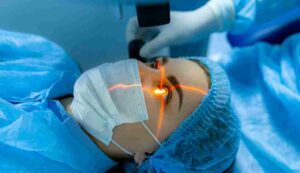Contents
What Is LASIK Surgery?
 LASIK (Laser-Assisted in Situ Keratomileusis) surgery is a popular refractive eye surgery used to correct vision problems such as nearsightedness, farsightedness, and astigmatism. During this, a laser is used to reshape the cornea to improve the way it focuses light onto the retina. This helps to reduce or eliminate the need for glasses or contact lenses. LASIK is a safe and effective procedure that has been performed on millions of people worldwide.
LASIK (Laser-Assisted in Situ Keratomileusis) surgery is a popular refractive eye surgery used to correct vision problems such as nearsightedness, farsightedness, and astigmatism. During this, a laser is used to reshape the cornea to improve the way it focuses light onto the retina. This helps to reduce or eliminate the need for glasses or contact lenses. LASIK is a safe and effective procedure that has been performed on millions of people worldwide.
What Is PRK Surgery?
PRK (Photorefractive Keratectomy) is another type of refractive eye surgery used to correct vision problems, similar to LASIK. We can say that PRK is a type of LASIK involving a different technique in order to suit the patient’s needs.
The Common Procedure In LASIK And PRK
 While LASIK (Laser-Assisted in Situ Keratomileusis) and PRK (Photorefractive Keratectomy) differ in certain aspects, they share a common procedure for correcting vision problems. Here is a general outline of the common steps involved in both surgeries:
While LASIK (Laser-Assisted in Situ Keratomileusis) and PRK (Photorefractive Keratectomy) differ in certain aspects, they share a common procedure for correcting vision problems. Here is a general outline of the common steps involved in both surgeries:
- Preoperative Assessment: Before the surgery, a comprehensive eye examination is conducted to evaluate the individual’s eye health, determine the degree of refractive error, and assess candidacy for the procedure.
- Numbing Eye Drops: Before the surgery, numbing eye drops are administered to ensure the patient’s comfort during the procedure.
- Corneal Preparation: In LASIK, a thin corneal flap is created on the outer layer of the cornea using a microkeratome blade or a femtosecond laser. In PRK, the outer layer of the cornea (epithelium) is removed completely. This is the step where the difference lies between the two.
- Laser Reshaping: After the corneal preparation, a specialized excimer laser is used to reshape the underlying corneal tissue. The laser emits precise pulses of ultraviolet light, removing microscopic amounts of tissue to reshape the cornea according to the patient’s refractive error.
- Postoperative Care: Following the laser treatment, the cornea undergoes natural healing. In LASIK, the corneal flap is repositioned, acting as a protective covering. In PRK, the removed epithelium regenerates over time. The patient is typically prescribed medicated eye drops to promote healing and prevent infection.
- Follow-up Visits: After the surgery, a series of follow-up visits are scheduled to monitor the healing process and assess the visual outcomes. These visits allow the eye care professional to ensure that the eyes are healing properly and to address any postoperative concerns.
Difference Between LASIK And PRK Surgeries
LASIK and PRK are both refractive eye surgeries used to correct vision problems, but they differ in the way the cornea is treated during the procedure. The major difference between LASIK and PRK is in the procedure of corneal preparation, healing time, and suitability for the patient.
1. Corneal Preparation
 In LASIK, a thin flap is created on the outer layer of the cornea using a microkeratome blade or a femtosecond laser.
In LASIK, a thin flap is created on the outer layer of the cornea using a microkeratome blade or a femtosecond laser.
In PRK, the outer layer of the cornea called the epithelium, is completely removed using alcohol. The epithelium naturally regenerates over time.
2. Healing Time
As a result, LASIK generally has a faster recovery time and less discomfort. It takes two to three days for the patient to get back his correct vision. While PRK may have a slightly longer recovery period and initial discomfort during epithelial healing. This is because the epithelium is chemically removed and hence, should be allowed to heal to get back the correct vision.
3. Suitability
The choice between LASIK and PRK depends on factors such as corneal thickness, corneal health, and the specific needs and preferences of the patient. Patients with thin cornea are recommended for PRK because only a few epithelial cells are removed from it.
LASIK And PRK: Which One Is Better?
 The decision between LASIK (Laser-Assisted in Situ Keratomileusis) and PRK (Photorefractive Keratectomy) depends on various factors, including the individual’s eye health, corneal thickness, refractive error, and personal preferences. Both procedures have their advantages and considerations:
The decision between LASIK (Laser-Assisted in Situ Keratomileusis) and PRK (Photorefractive Keratectomy) depends on various factors, including the individual’s eye health, corneal thickness, refractive error, and personal preferences. Both procedures have their advantages and considerations:
LASIK advantages:
- Faster recovery: LASIK typically involves a quicker visual recovery and less discomfort compared to PRK. Many patients notice improved vision within a day or two.
- Corneal stability: The corneal flap created during LASIK provides stability to the cornea, reducing the risk of flap dislocation. This allows for an earlier return to normal activities.
- Suitable for higher refractive errors: LASIK is often preferred for individuals with higher degrees of myopia (nearsightedness) or hyperopia (farsightedness) and astigmatism.
PRK advantages:
- Corneal thickness: PRK is a suitable option for individuals with thinner corneas. This is so as it does not require the creation of a corneal flap.
- Corneal integrity: PRK preserves the structural integrity of the cornea by not creating a flap. This may be beneficial for certain patients.
- Avoidance of flap-related complications: Since PRK does not involve a corneal flap, it eliminates the possibility of flap-related complications. Such as flap dislocation or flap-related dry eye.
The eye care professional will consider factors such as your eye health, corneal thickness, refractive error, lifestyle, and expectations to determine which procedure is better suited for you.
Cost Of LASIK And PRK Surgeries
 The cost of LASIK (Laser-Assisted in Situ Keratomileusis) and PRK (Photorefractive Keratectomy) surgeries can vary depending on several factors. These may include the location, the specific clinic or surgeon, the technology used, and any additional services included. However, there are some general differences to consider:
The cost of LASIK (Laser-Assisted in Situ Keratomileusis) and PRK (Photorefractive Keratectomy) surgeries can vary depending on several factors. These may include the location, the specific clinic or surgeon, the technology used, and any additional services included. However, there are some general differences to consider:
LASIK eye surgery cost in India may depend upon the type of LASIK delivered, such as standard LASIK, C-LASIK, Contoura, or others. The standard LASIK may range between INR 10-20K per eye. For other special or customized LASIK surgeries, it may be higher, ranging from INR 20K to 50K per eye.
In general, the cost of PRK surgeries often ranges between INR 30K-40K per eye. Again, the cost may depend on the type of equipment and techniques used in the surgery.
Conclusion
In conclusion, LASIK and PRK are two common refractive eye surgeries used to correct vision problems. LASIK involves creating a corneal flap, while PRK removes the outer layer of the cornea. The choice between LASIK and PRK depends on factors such as corneal thickness and personal preferences. Both procedures have their advantages and considerations. To make an informed decision about which procedure is right for you, it is important to consult with an experienced eye care professional. Seek help from a qualified professional to determine the best option for your specific needs.
Lasik surgery is a safe 10-minute procedure to help you get rid of glasses. EyeMantra offers the most advanced LASIK options including PRK, Femto LASIK, SMILE surgery, Standard LASIK, ICL, and Contoura vision. If you have any questions on LASIK surgery in Delhi, Lasik surgery cost, and Lasik procedure, call us at 9711116605 or email at [email protected].


